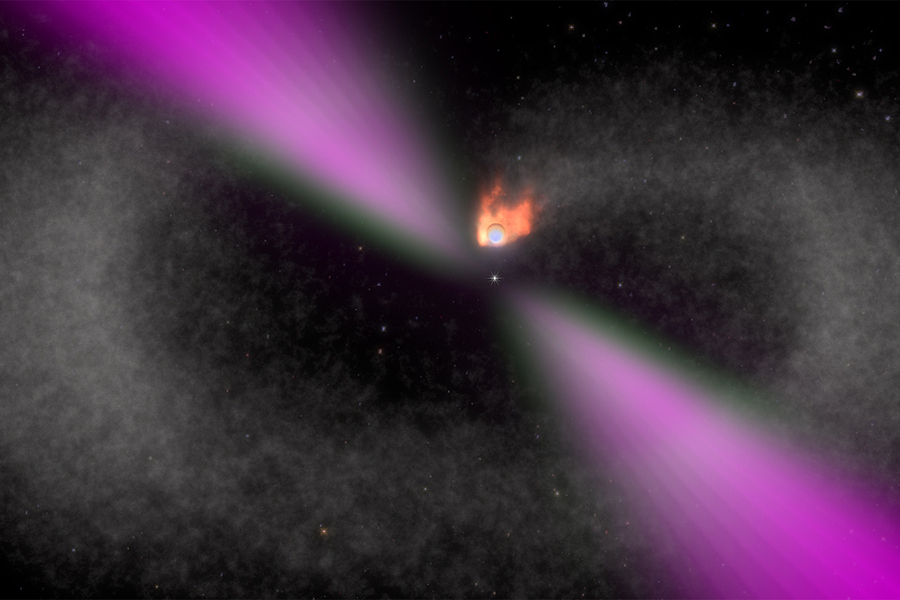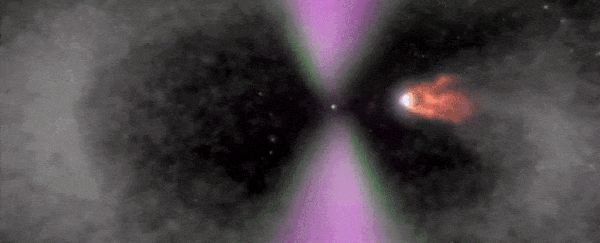There are some strange objects lurking in our galaxy, and astronomers have just spied an extreme new candidate roughly 3,000 to 4,000 light-years away.
After investigating mysterious flashes of light coming from the system, researchers have detected what they suspect is an elusive 'black widow' star – a rapidly spinning pulsar that's kept alive by slowly devouring its smaller companion star.
Black widow pulsars are rare at best – we only know of a dozen or more of them in the Milky Way. But this one appears to be among the most extreme, and arguably most bizarre, examples of the phenomenon we've ever found.
Named ZTF J1406+1222, the binary system has the shortest orbital period yet seen, with the 'black widow' and its prey circling each other every 62 minutes.
Even more peculiar, the system seems to host a third, far-flung star that takes roughly 12,000 years to orbit the other two.
"This system is really unique as far as black widows go, because we found it with visible light, and because of its wide companion, and the fact it came from the galactic center," says lead researcher and physicist Kevin Burdge from MIT's Department of Physics.
Pulsars arise when the cores of massive supergiant stars collapse into neutron stars. When these neutron stars are highly magnetized and rapidly spinning, they become what we call a pulsar.
Like ultra-bright lighthouses in the Universe, pulsars spin around extremely rapidly and shine X-rays and gamma rays towards us at intervals ranging from more than one a second, down to periods that can be counted in milliseconds. Normally pulsars spin fast and die young, due to how much energy they're blasting out.
But if a passing star gets close enough, the pulsar can slowly suck material from it like a giant parasite, siphoning enough energy to continue spinning and feeding off the other star until it devours it.
"These systems are called black widows because of how the pulsar sort of consumes the thing that recycled it, just as the spider eats its mate," says Burdge.

In the past, astronomers have been alerted to these black widow systems through gamma rays or X-rays – high frequency radiation blasted out by the pulsar itself.
But the team used a new technique to find ZTF J1406+1222: they looked for visible light coming off the star being eaten.
It turns out the 'day' side of the companion star that's locked with the black widow can get many times hotter than the 'night' side, and this extreme variation in brightness is something that can be detected.
To test this idea, the researchers used data from Zwicky Transient Facility, an observatory in California, and were able to find the black widow systems we already know about, validating that the technique worked.
They then set about looking for new black widows, and came across ZTF J1406+1222, where the companion star changes in brightness by a factor of 13 every 62 minutes.
This is the first time a black widow pulsar has been found this way, and that's part of what makes the discovery so exciting.
 (NASA Goddard Space Flight Center/Cruz deWilde)
(NASA Goddard Space Flight Center/Cruz deWilde)
Above: The black widow's gamma-rays (magenta) heat the fiery 'day' side of the star.
The other part, of course, is the mysterious system they stumbled upon.
Not only are the black widow pulsar and its prey locked in the tightest cannibalistic spiral seen to date, but when the team looked back through measurements of the star using the Sloan Digital Sky Survey, they saw the system was being trailed by a rare low-metallicity cool subdwarf star, which appeared to only orbit the binary every 12,000 years.
The presence of this far-flung third star could make the system an unheard-of 'triple' black widow, and has astronomers scratching their heads about how the set-up could have formed in the first place.
Based on current observations, Burdge and his colleagues have a few ideas. Black widow binaries arise from a dense constellation of old stars known as a globular cluster.
One of the leading hypotheses is that, if this particular cluster drifted into the center of the Milky Way, then the gravity of our central black hole may have pulled the cluster apart while sparing only the triple black widow.
"It's a complicated birth scenario," says Burdge. "This system has probably been floating around in the Milky Way for longer than the Sun has been around."
Even weirder, while the team could detect ZTF J1406+1222 using visible light, when they looked back for gamma and X-rays, they couldn't actually see it – which suggests that it actually may not be a black widow at all.
"The one thing we know for sure is that we see a star with a day side that's much hotter than the night side, orbiting around something every 62 minutes," says Burdge.
"Everything seems to point to it being a black widow binary. But there are a few weird things about it, so it's possible it's something entirely new."
The team plans to continue observing the system to get a better idea of what's going on.
Intriguingly, it could be a prime candidate for learning more about neutron star 'kick' physics. Astronomers know that when neutron stars form they get a 'kick' that sends them speeding off at a high velocity.
But it's not fully understood where this kick comes from. The strange birth story of this mysterious system could shed light on the question.
"There's still a lot we don't understand about it. But we have a new way of looking for these systems in the sky."
The research has been published inNature.
